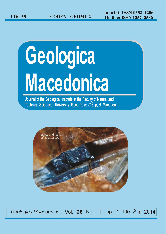Preliminary investigations of deterioration on monument to fallen soldiers in the second world wаr in Stip, Republic of Macedonia
Abstract
This paper gives an explanation of the origin and formation on the minerals which are formed as a consequence on deterioration. Several small marble samples were collected for research by Scanning electron microscopy (SEM), coupled with an energy dispersive X-ray spectrometer (EDS). SEM is especially useful because it gives elemental, mineralogical and morphological data at the same time. Loss of face characters and presence of black crusts are evident. The results show that the black crusts consisting of gypsum, calcite and elements such as Si, Al, Fe, Pb, Ti, Zn and Mn, were being formed from interaction between the marble surface and atmospheric pollutants. Dissolution of calcite from the surface by rain water, CO2 and SO2 enables the Fe compounds to become enriched and oxidized on the surface. Clay minerals are occur in the finishing layers covering the surface on the monument and they originated from atmospheric dust naturally deposited.
Key words: мarble; deterioration; black crust; soil dust; environmental conditions

